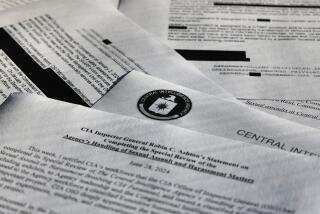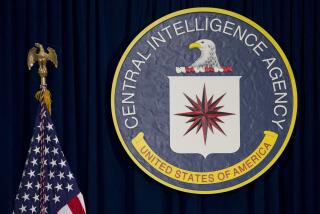Timeline: The history of the CIA detention and interrogation program
A timeline of the CIA’s detention and interrogation program and its oversight provided by the Senate Select Committee on Intelligence.
Sept. 11, 2001: Al Qaeda carries out terrorist attacks against the World Trade Center and the Pentagon.
Sept. 17, 2001: President George W. Bush signs a classified covert action memorandum authorizing the CIA to detain terrorists.
Feb. 7, 2002: President Bush signs a memorandum stating that the Geneva Conventions do not apply to the global conflict with al Qaeda.
March-April 2002: Abu Zubaydah is captured in Pakistan and transferred to CIA custody. He is interrogated jointly by FBI and CIA officers.
June 2002: CIA officers place Abu Zubaydah in isolation for 47 days. The FBI never returns to the CIA interrogation site.
Aug. 1, 2002: The Justice Department’s Office of Legal Counsel (OLC) issues two memorandums (one classified and one unclassified) concluding that the CIA’s proposed “enhanced interrogation techniques” did not violate the federal anti-torture statute. The classified memorandum addressed specific techniques, including waterboarding, for use on Abu Zubaydah.
Aug. 4-30, 2002: After a prolonged period of isolation, Abu Zubaydah is subjected to near-constant coercive interrogation techniques by CIA officials, including the first application of waterboarding.
September 2002: Sen. Bob Graham (D-Fla.), chairman of the Senate Select Committee on Intelligence, and Richard Shelby (R-Ala.), vice chairman of the committee, are first briefed on the CIA interrogation program. [Later, Sens. Pat Roberts (R-Kan.) and Jay Rockefeller (D-W.Va.) are briefed when they become chairman and vice chairman, respectively.]
November 2002: After being captured and detained by a foreign country, Abd al Rahim al Nashiri is transferred to CIA custody and transported to the same detention facility where Abu Zubaydah is located. Nashiri is also subjected to the CIA’s coercive techniques, including waterboarding. [Interrogations during this period are videotaped.]
November 2002: CIA detainee Gul Rahman dies while being held and interrogated by the CIA at a separate CIA detention facility from where Abu Zubaydah and Nashiri are held.
Dec. 28, 2002-Jan. 1, 2003: Nashiri is threatened with a handgun and drill during a CIA interrogation.
January 2003: The CIA Office of Inspector General begins a review of the CIA’s detention and interrogation program.
March 2003: Khalid Sheikh Muhammad is captured and transferred to a CIA detention site where he is subjected to the CIA’s coercive interrogation techniques, including 183 instances of waterboarding.
July 2003: The CIA and some members of the National Security Council meet and reaffirm the use of the CIA’s so-called enhanced interrogation techniques.
Sept. 16, 2003: The CIA first briefs the secretaries of State and Defense on the CIA’s enhanced interrogation techniques, according to CIA records.
May 7, 2004: The CIA’s inspector general completes a review of the CIA’s detention and interrogation program.
June 2004: The OLC withdraws its unclassified Aug. 1, 2002, memorandum containing a legal analysis of the anti-torture statute. While the OLC begins to draft a new memorandum, the CIA continues to interrogate detainees in its custody.
August-September 2004: The OLC issues letters to the CIA advising that the use of the CIA’s enhanced interrogation techniques against specific, named detainees does not violate the federal anti-torture statute.
Dec. 30, 2004: The OLC issues a revised, unclassified memorandum that supersedes the withdrawn unclassified Aug. 1, 2002 memorandum.
May 2005: The OLC provides three classified legal memorandums. The first two, issued on May 10, 2005, address the legality of the CIA’s coercive interrogation techniques, individually and in combination, under the federal anti-torture statute. The third memorandum, issued on May 30, 2005, analyzes the techniques under Article 16 of the Convention Against Torture.
Nov. 2, 2005: The Washington Post publishes an article about the existence of a secret, global detention and interrogation program run by the CIA.
Nov. 8-9, 2005: Contrary to the direction from the White House and the office of the director of national Intelligence, the director of the CIA’s National Clandestine Service, Jose Rodriguez, authorizes the destruction of videotapes depicting the use of the CIA’s coercive interrogation techniques, including waterboarding, against Abu Zubaydah and Nashiri from 2002.
December 2005: Congress passes the Detainee Treatment Act, prohibiting the use of “cruel, inhuman, or degrading treatment or punishment” against any “individual in the custody or under the physical control of the United States government.”
June 29, 2006: The Supreme Court, in Hamdan vs. Rumsfeld, holds that Common Article 3 of the Geneva Conventions applies to the U.S. conflict with Al Qaeda and that detention at Guantanamo must comply with the Geneva Conventions.
Aug. 31, 2006: The Office of Legal Counsel issues a memorandum analyzing the application of the Detainee Treatment Act to the conditions of confinement for CIA detainees.
Sept. 6, 2006: Members of the Senate Select Committee on Intelligence other than the chairman and vice chairman are briefed on the CIA’s detention and interrogation program for the first time. The briefing was limited, as the administration was preparing for the public acknowledgement of the CIA program by President Bush hours later that same day. In his speech, the President provides specific claims of plots thwarted and terrorists captured, attributing much of this information to the CIA’s use of an “alternative set of [interrogation] procedures.”
Sept. 28-29, 2006: Congress passes the Military Commissions Act, which provides that particular violations of Common Article 3 of the Geneva Conventions are subject to criminal prosecution under the War Crimes Act. The Military Commissions Act provided that the president has the authority “to interpret the meaning and application of the Geneva Conventions and to promulgate higher standards and administrative regulations for violations of treaty obligations which are not grave breaches of the Geneva Conventions.”
July 20, 2007: President Bush signs Executive Order 13440 stating that the CIA’s detention and interrogation program “fully complies with the obligations of the United States under Common Article 3,” and authorizes the CIA’s continued use of certain interrogation practices as determined by the CIA director. In conjunction with the release of the executive order, the OLC issues a memorandum analyzing the legality of the techniques under Common Article 3 of the Geneva Conventions, the Detainee Treatment Act and the War Crimes Act.
Dec. 6, 2007: The New York Times reports that the CIA destroyed interrogation videotapes in November 2005. The CIA acknowledges that the interrogation videotapes — depicting CIA interrogations using the CIA’s enhanced interrogation techniques in 2002 — were destroyed.
Dec. 11, 2007: In a hearing before the Senate Select Committee on Intelligence, CIA Director Hayden offers to allow a small number of committee staff to review CIA operational cables that describe the interrogation sessions that had been videotaped, given that the video recordings had been destroyed.
Jan. 2, 2008: Atty. Gen. Michael Mukasey selects Assistant U.S. Atty. John Durham to lead a criminal investigation into the destruction of interrogation videotapes by the CIA.
March 8, 2008: President Bush vetoes the Intelligence Authorization Act for Fiscal Year 2008, which would have limited CIA interrogations to techniques authorized by the Army Field Manual.
Jan. 22, 2009: President Obama issues Executive Order 13491, rescinding Executive Order 13440, banning the CIA’s detention authority, and restricting the CIA to interrogation techniques authorized by the Army Field Manual.
Feb. 11, 2009: The Senate Select Committee on Intelligence meets to formally review a committee staff memo summarizing the CIA cables describing the interrogation of Abu Zubaydah and Nashiri (see Dec. 11, 2007 entry).
March 5, 2009: The Senate committee votes, 14-1, to open an investigation into the CIA’s detention and interrogation program.
March 26, 2009: Senate Select Committee on Intelligence Chairman Sen. Dianne Feinstein (D-Calif.) and Vice Chairman Sen. Kit Bond (R-Mo.) send a document request to CIA Director Leon Panetta for information relating to the CIA’s detention and interrogation program.
April 16, 2009: Atty. Gen. Eric H. Holder Jr. publicly releases four Department of Justice legal memorandums written during the CIA program that examine the legality of the CIA’s enhanced interrogation techniques. President Obama announces that the Department of Justice will not pursue criminal proceedings against CIA officials found to have participated in interrogations consistent with the legal memorandums.
April-May 2009: The Senate Select Committee on Intelligence and the CIA exchange letters regarding the committee’s investigation of the CIA’s detention and interrogation program, covering the information to be provided by the CIA, as well as how and where the information would be reviewed and documented by staff. Documents begin to be provided to the committee staff at an off-site facility in the summer of 2009.
Aug. 24, 2009: Holder announces that the Department of Justice is expanding its initial review (see Jan. 2, 2008, entry) of the CIA’s destruction of interrogation videotapes to include the potential use of unauthorized interrogation techniques by CIA officers that were not included in previous Department of Justice legal memorandums.
Sept. 25, 2009: Bond announces the Senate committee minority’s withdrawal from the committee’s study following Holder’s Aug. 24, 2009, announcement.
February 2010: CIA personnel remove approximately 870 documents from the committee staff’s access at the CIA off-site facility.
May 2010: CIA personnel remove an additional 50 documents from committee staff’s access at the CIA off-site facility.
Late 2010: Senate Select Committee on Intelligence staff are provided access to a set of documents now referred to as the “Panetta Review,” an internal CIA review of agency records related to its detention and interrogation program.
June 30, 2011: Holder announces that the review by Durham was being narrowed to a full criminal investigation regarding the death of two individuals, but not other CIA detention and interrogation activities.
Oct. 20, 2011: Senate Select Committee on Intelligence staff begin distributing to all members and staff the first portions of the full committee study. (Additional sections are provided on Dec., 2011; Feb. 29, 2012; June 29, 2012; Aug. 3, 2012; Sept. 13, 2012; and Nov. 16, 2012.)
April 30, 2012: Feinstein and Senate Armed Services Committee Chairman Sen. Carl Levin (D-Mich.) announce in a press release that the CIA’s enhanced interrogation techniques did not produce the information being cited in the press that led to the location of Osama bin Laden.
Aug. 30, 2012: Holder announces that the Department of Justice would not seek to prosecute any CIA employees in connection with the deaths of two detainees.
Dec. 13, 2012: The Senate Intelligence Committee votes, 9-6, to approve the committee study as an official committee report (eight Democrats and one Republican voted yes). The committee study is sent to the executive branch for comment, with a request that the executive branch respond by Feb. 15, 2013.
Feb. 7, 2013: During his confirmation hearing to be director of the CIA, John Brennan testifies that he had read the executive summary of the committee’s study and learned new details about the program, but states that he needs to “see what CIA’s response is.”
March 7, 2013: Brennan is confirmed as CIA director. The same day, the Wall Street Journal quotes an unidentified senior intelligence official as saying that the CIA objected to most of the committee’s study.
June 27, 2013: Brennan provides to the Senate Select Committee on Intelligence the CIA’s response to the committee study. Feinstein commits to updating the study as appropriate to ensure the study is fully accurate and takes into account the CIA’s response. Committee staff and CIA representatives meet at least 13 times in August and early September 2013 to discuss the CIA’s response.
August 2013: The CIA’s general counsel, Stephen Preston, in his response to questions for the record submitted in connection with his nomination to be general counsel of the Department of Defense, states that the “DOJ did not always have accurate information about the detention and interrogation program,” and that he considered “information of this nature to be material.” Preston also stated that CIA briefings to the committee “included inaccurate information related to aspects of the program of express interest to members.”
Nov. 26, 2013: Feinstein sends a letter to Brennan requesting that the CIA provide the committee with the full Panetta Review, given that the internal CIA review agrees with the committee’s study and stands in stark contrast to the CIA’s official response.
Early January 2014: The CIA refuses to provide the Panetta Review, claiming the document is “privileged.”
Jan. 15, 2014: Feinstein and Senate Select Committee on Intelligence Vice Chairman Sen. Saxby Chambliss (R-Ga.) meet with Brennan, who states that the CIA had conducted a “search” of committee computers at the CIA facility in order to determine whether the committee staff had obtained a copy of the Panetta Review. Brennan alleges that committee staff had inappropriately acquired the documents.
January-March, 2014: Representatives of the Senate Select Committee on Intelligence, CIA and White House discuss the allegations made about CIA and committee staff actions. CIA Inspector General David Buckley opens an investigation into the CIA’s conduct and provides a crimes report to the Department of Justice. Shortly thereafter, acting CIA general counsel Robert Eatinger provides a crimes report to the Department of Justice alleging the Senate committee staff engaged in criminal behavior.
March 11, 2014: Feinstein gives a 40-minute speech on the Senate floor responding to news reports about the dispute between the CIA and the committee. In her statement, she states the CIA may have violated the law when it searched committee computers at the CIA facility. Despite his private acknowledgements, (see Jan. 15, 2014, entry) Brennan publicly denies allegations that the CIA searched the computers used by the committee.
March 19, 2014: Senate Majority Leader Sen. Harry Reid (D-Nev.) writes to Brennan and Holder, notifying them that the Senate sergeant-at-arms would investigate CIA allegations that Senate Select Committee on Intelligence staff had inappropriately accessed CIA computer networks.
April 3, 2014: The Senate Intelligence Committee approves sending the committee study’s executive summary, findings and conclusions, to the White House for declassification review and public release by a vote of 11-3.
July 31, 2014: Buckley publicly releases a summary of his investigative findings, including that CIA employees acted inappropriately in accessing computers and email used by committee staff and that the criminal charges referred by the CIA’s acting general counsel about committee staff activities was based on erroneous information. Brennan privately apologizes to Feinstein and Chambliss for the actions of CIA personnel.
Aug. 1, 2014: The White House provides the Senate Select Committee on Intelligence with proposed redactions to the executive summary and findings and conclusions of the committee study.
August-December, 2014: In a series of meetings and phone calls, committee members and staff negotiate proposed redactions with the White House and other executive branch representatives.
More to Read
Sign up for Essential California
The most important California stories and recommendations in your inbox every morning.
You may occasionally receive promotional content from the Los Angeles Times.










